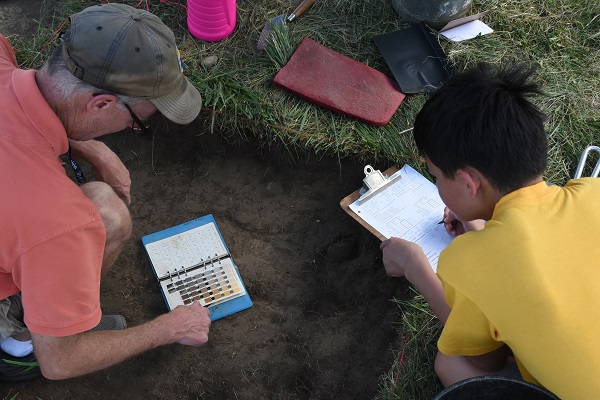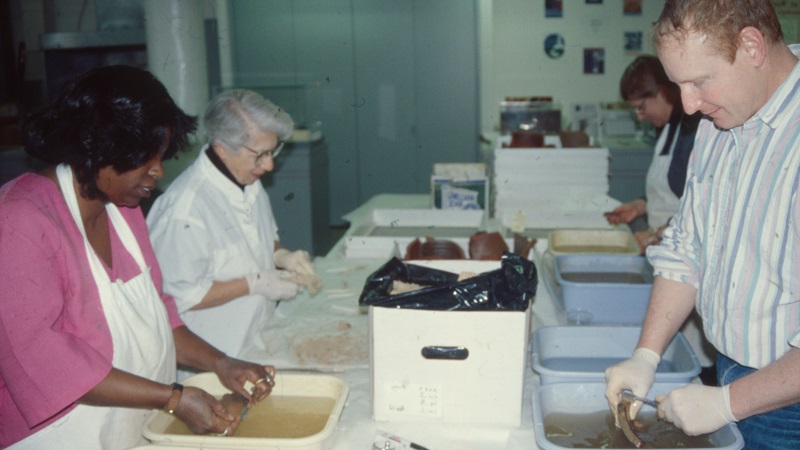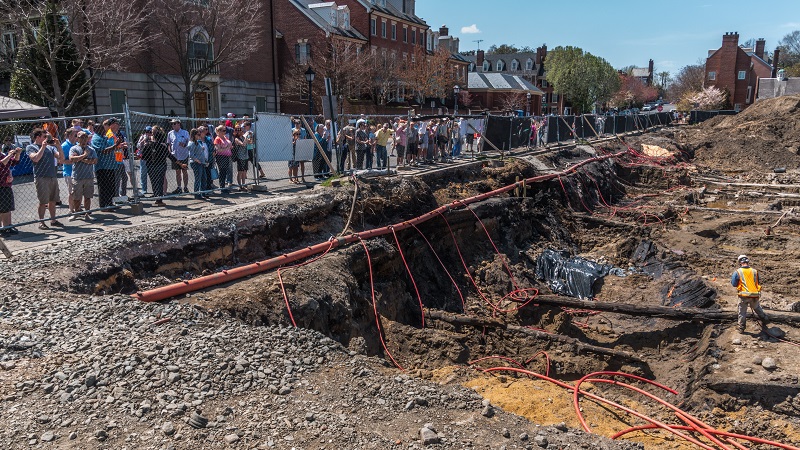Archaeological Process
Selecting the Site
"How do you find an archaeological site?" "How do you know where to dig?" These are questions that archaeologists hear numerous times. In Alexandria, archaeological sites are discovered in a variety of ways. City Archaeologists consult maps, deeds, census, tax and other records. Historic and Native American sites can also be located through field surveys (walking across the ground looking for artifacts). Sometimes sites are discovered by chance by home-owners who find artifacts, building foundations, abandoned wells or privies in basements and backyards. Such discoveries are visited by the City Archaeologists and are recorded with notes and photographs. Information is then added to Alexandria Archaeology's register of sites in the City.
The City of Alexandria has laws that protect archaeological sites so that information may be recovered before they are destroyed by development. Planning dockets and construction applications are reviewed to see if proposed commercial projects could disturb sites. The City archaeologists use Geographic Information Systems (GIS) to improve the efficiency and accuracy of the archaeological review process. Before construction work begins, a developer may be required to have an archaeological investigation conducted. Occasionally, the City Archaeologists choose to work on an important site that is not threatened, or that will be disturbed by small construction projects not covered by the City laws. There are many areas in the Historic Districts such as Del Ray, Rosemont, Northridge, and the West End that have the potential to yield information about Alexandria's historic and prehistoric past. Archaeologists in Alexandria view the entire City as an archaeological site.
How are maps and plats used by archaeologists?
Archaeologist Dr. Benjamin Skolnik chats about the importance of historic spatial information and shares more about how his work using Geographic Information Systems lets us learn more about our City’s buried past.
Conducting Research
Archaeologists rely on written information in their research. The archaeological study of places and time periods for which there is written history is known as historical archaeology.
Primary sources are the original written records from the period of time that is studied by archaeologists and historians and are the best type of written information. A newspaper such as The Alexandria Gazette, first published in 1784, is an excellent source for local history. Deeds, tax records, census records, photographs, diaries and maps are among the best primary sources for learning about the history of Alexandria sites. Secondary sources, such as history books, can be useful if they are accurate as stories or rumors that are loosely based on fact become embellished as they are passed from generation to generation. It is important for archaeologists and historians to distinguish between fact, opinion and legend.
Some notable places in Alexandria where archaeologists and historians conduct research are: the Alexandria Library, Special Collections at 717 Queen Street, which stores books, documents and microfilm on Alexandria and Virginia history; The Alexandria Court House at 520 King Street which holds legal records including deeds and wills, and the City Clerk's Office in City Hall, 301 King Street where City Council Minutes are kept.
What can be learned from old taxes, deeds, and insurance documents?
Archaeologist Dr. Garrett Fesler will chat about the importance of documentary research and how it helps us learn more about our City’s past and interpret its rich archaeological heritage.
Learn more about Documentary Research and Historical Archaeology.
Excavating the Site

Archaeologists make accurate maps of each site prior to excavation. The archaeologists first draw a base map that indicates where the site is located. During the excavation, the archaeologists add to the map to show which portions of the site were excavated and where features and artifacts were discovered. A datum point, or point of reference from a United States Geological Survey benchmark, is established, and measurements are taken from that point.
A grid is established over the site with string held by large nails or stakes. The grid is based on the cardinal points of the compass (north, south, east and west). Accurate measurements using the grid are taken using surveying equipment. Surveying instruments such as the traditional transit and stadia rod, or modern GPS surveying equipment, are used to produce these accurate maps of the site by measuring distances, angles, heights and depths. The accurate map and grid are necessary to maintain artifact provenience, and to take measurements and map features. Each excavation unit, or square, on the established grid is identified by a set of coordinates. The coordinates are designated by counting the number of units (meters or feet) north and east of the datum point. The datum point is located at the southwest corner of the site. Sometimes, only a few test squares within the site grid will be dug, while on other sites the entire area is excavated. Stratigraphy is the study of the strata, or soil layers, of an archaeological site. The effects of human and natural actions over a long period of time cause visible changes in the color and texture of the soil. The strata may have formed gradually by erosion, gardening activities and littering; or over a shorter period of time through activities such as construction, demolition, trash dumping, or land-filling.
Each stratum (an individual layer of soil and artifacts) is dug separately. Archaeologists start on the top layer and work their way down following the contour of each stratigraphic layer. The layers containing soil, structures and artifacts from different time periods are identified by careful excavation techniques. The archaeologists look for artifacts and any changes in the color and texture of the soil. These changes may indicate the beginning of a new layer.
As each layer is dug, it is measured and recorded on a special form. Artifacts are collected separately from each stratigraphic layer within each square so that their spatial relationship can be recorded. The artifacts are placed in a bag marked with the grid coordinates and the layer number. This exact location where the artifacts are found – the square, layer and feature – is called the provenience. Each provenience is assigned a unique record number, to help keep track of the artifacts.
Each layer represents a segment of time, much like a timeline. Archaeologists also encounter features while they are digging. Features are areas that appear different from the surrounding soil because the ground was disturbed in the past. Features are usually the result of human activity. Some examples of features are building foundations, abandoned wells and privies, trash pits and burials. Usually the lowest layers are the earliest, although features such as wells, foundations and post-holes may have been dug through earlier layers.
Archaeological excavation techniques are tailored to the individual site. In some circumstances, such as in the excavation of some wells, stratigraphic layers cannot be identified by soil color and consistency. When strata are either indistinguishable or very deep, arbitrary levels may be defined by the archaeologist. These arbitrary levels are all equal in depth (e.g., 10 cm. or 1 ft.) and provide a way to record the relative placement of artifacts within a larger layer or feature.
Archaeologists must be observant and aware of post-depositional factors, conditions that have occurred after the artifacts were deposited on the site. Seasonal weather changes, roots, worm and rodent activities can alter the placement or preservation of the artifacts. The very actions that can create a site, such as those noted above, may also affect the artifacts and features at a later time.
The basic tool for digging is the masons pointing trowel; the same type of trowel bricklayers, or masons, use. Trowels between three and five inches are most effective. Archaeologists use the trowel to scrape the soil carefully and evenly, while uncovering artifacts and looking for changes in soil color and texture which may indicate a feature or the beginning of a new level. The Munsell Color Chart provides standard names for the soil colors. Smaller tools such as dental picks and paint brushes are used for very fine work. Once soil has been scraped with the trowel into a dustpan, it is placed in a bucket and then sifted through a screen to ensure that no artifacts remain in it. The artifacts from each provenience are placed in separate labeled bags and brought to the Museum for processing.
A line level and plumb bob are used for mapping and drawing profiles of the stratigraphy seen on the side-wall of an excavation unit. Standardized record forms ensure that the same types of data are collected from every part of the site.
Cleaning and Cataloguing Artifacts

Excavation is only a small part of an archaeologist's work. After excavation, the job of cleaning, analyzing and interpreting begins. In urban archaeology, it is estimated that for every hour of excavation it takes at least twenty hours of laboratory and other work to complete an analysis and report. Often this study and analysis continues for years after the excavation has been completed.
Although the discovery of artifacts is exciting, it is important to remember that the archaeologist is not just looking for individual objects. As strange as it may seem, one or two spectacular artifacts may not be regarded as any more "valuable" than the other hundreds or thousands of objects uncovered during the excavation. Interesting artifacts are frequently displayed in exhibitions to provide information and insight into the culture the archaeologist is studying. The artifacts, however, are not regarded as antiques and given a monetary value. The value is what the entire collection or assemblage can tell the archaeologist about the site and the events that happened there through time. The thousands of artifacts recovered from each site are washed, sorted and marked by volunteers. Each artifact is then catalogued and analyzed with others found in the same context.
Cleaning Artifacts: Artifacts arrive in the Alexandria Archaeology Laboratory from the sites in bags and boxes labeled according to the provenience, the specific location where an artifact or feature is found in the ground. Ceramics, glass and bones in good condition are washed with a toothbrush in a basin of plain water, as detergents can cause chemical reactions that damage the artifacts. Artifacts are then placed in a drying rack for at least 24 hours to insure that the artifacts are completely dry before they are stored in plastic bags. Some types of artifacts may be treated differently. For example, metals may be cleaned with a soft, dry brush to remove surface dirt, and stored in a dry environment prior to conservation. Waterlogged wood, leather and cloth artifacts are sprayed with fungicide and placed in sealed plastic bags on site until they are brought to the lab. They are then cleaned with a gentle water spray and stored in water prior to conservation. Once cleaned, it is important to keep all materials from each unit and level together until marked with the provenience.
Archaeological Conservation: The main goal of archaeological conservation is to stabilize artifacts for long-term preservation. Depending on the condition of the artifact, this can involve chemical treatments, mechanical cleaning, or simply storage in the proper environment.
Sorting and Marking Artifacts: When dry, the artifacts are sorted within each provenience into categories such as ceramics, glass, structural material (window glass, nails), miscellaneous (buttons, pipes, toys), organic artifacts (cloth and leather), bone, shell and seeds.
All ceramic and glass vessel fragments are marked with a special waterproof ink pen with the site and provenience numbers. Artifact assemblages (all artifacts from the same provenience) are studied together, therefore it is important that each artifact is always marked or accompanied by a label.
Crossmending Ceramics and Glass: Crossmending is the process of piecing sherds together to form a vessel, regardless of where the artifact fragments were found on the site. This is usually done with fragments found in a large feature, such as a well or trash pit. The crossmended vessels are held together temporarily with tape to reveal the shape and size, and for photography. Artifacts are only restored with glue if they are to be exhibited, as restored vessels require more storage space and are subject to breakage. This process is like doing many three-dimensional jigsaw puzzles at the same time, and requires good spatial skills, persistence, and an eye for detail. Fragments of each crossmended vessel are bagged separately and given an individual catalogue number.
Cataloguing: Cataloguing is the most difficult part of laboratory work. Alexandria Archaeology uses an illustrated glossary put together for in-house use, study collections, an extensive library of books, and the internet for aid in artifact identification. The staff and volunteers refer to a notebook of standardized terms to be used in cataloguing artifacts, to provide consistency and accuracy.
Each artifact or each group of artifacts with the same description (e.g., five sherds of plain creamware body sherds; two bone 4-hole buttons with the same measurements; 50 fragments of window lass) are assigned a catalogue number, and described on a catalogue sheet. The information is entered into a computer database, along with digital images of the artifacts. The database can then be used to manipulate the artifact catalogue to analyze the site.
Faunal Analysis: Faunal analysis, the study of animal bones, is also an important area of study in the lab. Faunal studies can tell us about the diets, types of livestock, socioeconomic status of the people, butchering practices, foodways, as well as the economy of the period. Faunal analysis requires a lot of specialized knowledge, and is normally done by consultants.
Analysis and Interpretation: One aspect of interpretation is to determine the period or periods of time that the site was occupied. After the ceramics, glass and miscellaneous artifacts are identified and catalogued, artifact groups from each provenience are studied as a unit. These artifacts provide the archaeologist with a point to begin their study of the site. Manufactured products are very useful because their date and place of manufacture can often be identified according to advances in technology and changes in stylistic preferences. Archaeologists must then estimate when the artifacts were discarded. This is known as the date of deposition. This can be a specific point in time or a span of many years, decades or even centuries. The concept of terminus post quem, Latin for 'the date after which', is used to determine the date of deposition, such as when a layer of trash was dumped into a pit or abandoned well. All of the artifacts found together in one level had to have been put there after the date that the newest artifact was manufactured. The date when this most recent artifact was first manufactured is known as the terminus post quem.
Stratigraphy, the study of the layers of the earth that contain artifacts is a relative dating techniques which tell us the order in which things occurred, but not the exact date something happened. Seriation, a graphical comparison of a series of artifact assemblages that have been put in chronological order based on their similarities, is often used when stratigraphy is lacking, such as in surface collections. The sequence of events on the site is determined by analyzing the various types of artifacts recovered from the site.
Absolute dating techniques using scientific methods, such as Radiocarbon (Carbon 14) or Potassium-Argon, are not used on American historic sites, but can be very useful for prehistoric sites. These techniques are expensive, are only used on organic material (ceramics and glass are non-organic), and have a margin of error that can be as much as plus or minus 250 - 500 years. Because manufacturing information and dated samples of artifacts are available for the historic period, these absolute dating techniques are not necessary.
Collection Storage: The Alexandria Archaeology Museum stores collections and related field records, catalogues and other supporting documentation from most excavations within the Alexandria city limits – whether the sites were excavated by staff or by archaeological resource management firms. The artifacts are stored in appropriate bags, boxes and other storage materials, and in a storage facility with a stabile climate, in order to ensure their long-term preservation. A database helps track the location of the artifacts, as well as their catalogue descriptions.
What happens to archaeological materials once they’ve been excavated?
Go behind the scenes with archaeologist and collections manager Tatiana Niculescu to look at the City’s efforts to preserve, research, and exhibit artifacts both big and small.
Reporting the Results

The interpretation of the data gathered from the excavation is an ongoing and lengthy process, but cannot be overlooked. There is no point to digging and analyzing the artifacts unless you are prepared to find out what all of the information means. Ultimately, interpretation takes the form of publications such as site reports and books, as well as lectures or exhibitions.
For archaeologists in Alexandria, the interpretation of each site adds to our knowledge of the growth and development of the City. It also provides a clearer understanding of how we arrived at our current state and the possibilities for our future.
Site reports, journal articles, book chapters, theses and papers on archaeology in Alexandria are listed in an online Alexandria Archaeology Bibliography. A number of the reports and publications can be read online, and some can be ordered from the Historic Alexandria Museum Shop.